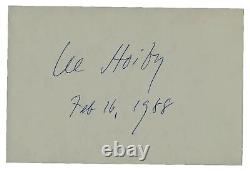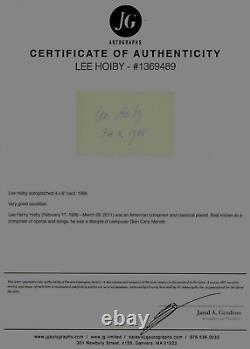Classical Pianist Lee Hoiby Hand Signed 4X6 Card Dated 1988 JG Autographs COA




"Classical Pianist" Lee Hoiby Hand Signed 4X6 Card Dated 1988. This item is certified authentic by. And comes with their Letter of Authenticity. (February 17, 1926 - March 28, 2011) was an American. Best known as a composer of.
And songs, he was a disciple of composer. Like Menotti, his works championed lyricism at a time when such compositions were deemed old fashioned.
His most well known work is his setting of. Which premiered at the St Paul Opera in 1971. He began playing the piano at the age of 5. He then became a pupil of. Hoiby became influenced by a variety of composers, particularly personalities in the twentieth century avant garde, including the. During his youth, Hoiby played with. Following his studies at Mills College, he entered the. Where he was mentored in music composition by. Who introduced Hoiby to opera, and involved him in the Broadway productions of. The Saint of Bleecker Street.Though at first he intended to pursue a career as a concert pianist, he eventually became more interested in composing. Hoiby died on March 28, 2011, aged 85, in New York City from metastatic melanoma.
He was survived by his partner and longtime collaborator, Mark Shulgasser. A chamber opera in one act, which was produced by Menotti and premiered in 1957, was recognized by. And the Italian press as the hit of the first. 1964, now known in its revised version as. A Month in the Country. Based on a play by. Was also praised by critics. Is perhaps his most famous work. And it was premiered in 1971 by St Paul Opera. Among Hoiby's other operatic works are the one-act opera buffa.Something New for the Zoo. Which was produced off-Broadway in 1989 with. (1986), and a one-act chamber opera. This Is the Rill Speaking. (1992), text by Lanford Wilson.
He contributed the song, "The Darkling Thrush, " with text by. Elements of this song were used as source material for the opera's remaining solo and ensemble music, written by composer. Hoiby's last opera was a setting of. (2004), which still awaits its world premiere. He continued his work with Bishop's poetry in a new chamber work, commissioned by American Opera Projects, with scenario by.For mezzo-soprano, baritone, piano and instrumental ensemble, lasting approximately one hour. An excerpt from the piece received its first reading in New York at New York City Opera's "VOX: Showcasing American Opera" program in May 2006. Summer Suite for Wind Ensemble.
Was premiered on February 25, 2008, by the Austin Peay State University Wind Ensemble under the direction of Dr. The composer elaborates on the history of the piece: Summer Suite is a transcription for concert band of one of my first orchestral works. The last movement is a rousing parade, and when the opportunity presented itself last year I decided to recast it for concert band. Greg Wolynec and his players at Austin Peay State University enjoyed it sufficiently to encourage me to work on the first two movements for them.
Rethinking the first movement (which was originally titled Scherzo) was a challenge and education, particularly in dealing with the lack of high strings, and tempo considerations. The second movement was a piece of cake, and I'm especially pleased with the way the long theme fits the french horn. I feel like my twenty-six year old self has made a gift to my present self. In 2006 to the words of U. Jesse Givens, who died in an accident while serving in Iraq. Introduced many of his best known songs and arias to the public. His songs are known for being inspired by music from many time periods and cultures. He comments about songwriting What I learned from. Came from a long, deep and loving exposure to his songs. A lot happens on a subconscious level, so it's hard to verbalize, but what I think his songs taught me have to do primarily with the line, the. The tessitura, the accentuations of speech, the careful consideration of vowels, the breathing required, and an extremely economical use of accompaniment material, often the same figure going through the whole song. One of the early proponents of Hoiby's songs in Europe was the soprano. Who, in the 1980s, recorded several of Hoiby's songs for Südwestfunk Baden-Baden, Germany with conductor. His choral music is widely performed throughout the US and in Great Britain. Indeed, some of his most important works are in that form, including the Christmas cantata A Hymn of the Nativity text by., the oratorio Galileo Galilei libretto by. , and a substantial group of works for chorus and orchestra on texts of.


